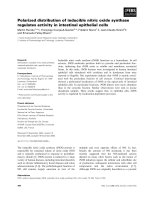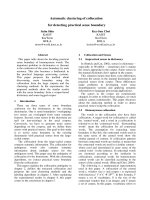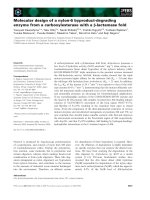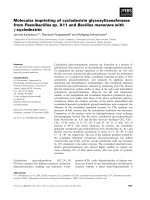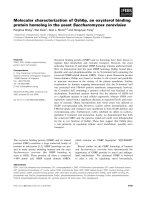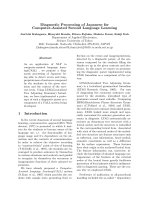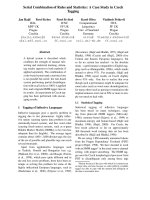Báo cáo khoa học: "Early results of quality of life for curatively treated rectal cancers in Chinese patients with EORTC QLQ-CR29." potx
Bạn đang xem bản rút gọn của tài liệu. Xem và tải ngay bản đầy đủ của tài liệu tại đây (223.89 KB, 8 trang )
RESEARCH Open Access
Early results of quality of life for curatively
treated rectal cancers in Chinese patients with
EORTC QLQ-CR29
Junjie Peng
1†
, Debing Shi
1†
, Karyn A Goodman
2
, David Goldstein
3
, Changchun Xiao
1
, Zuqing Guan
1
and
Sanjun Cai
1*
Abstract
Purpose: To assess the quality of life in curatively treated patients with rectal cancer in a prospectively collected
cohort.
Methods: Patients with stage I-III rectal cancer who were treated curatively in a single institution were accrued
prospectively. Quality of life was assessed by use of the European Organization for Research and Treatment of
Cancer questionnaire module for all cancer patients (QLQ-C30) and for colorectal cancer patients (QLQ-CR29).
Quality of life amo ng different treatment modalities and between stoma and nonstoma patients was evaluated in
all patients.
Results: A total of 154 patients were assessed. The median time of completion for the questionnaires was 10
months after all the treatments. For patients with different treatme nt modalities, faecal incontinence and diarrhea
were significantly higher in radiation group (p = 0.002 and p = 0.001, resp ectively), and no difference in male or
female sexual function was found between radiation group and non-radiation group. For stoma and nonstoma
patients, the QLQ-CR29 module found the symptoms of Defaecation and Embarrassment with Bowel Movement
were more prominent in stoma patients, while no difference was detected in scales QLQ-C30 module.
Conclusions: Our study provided additional information in evaluating QoL of Chinese rectal cancer patients with
currently widely used QoL questionnaires. As a supplement to the QLQ-C30, EORTC QLQ-CR 29 is a useful
questionnaire in evaluating curatively treated patients with rectal cancer. Bowel dysfunction (diarrhea and faecal
incontinence) was still the major problem compromising QoL in patients with either pre- or postoperative
chemoradiotherapy.
Introduction
Colorectal cancer is the second most common cause of
cancer death in developed countries and has become an
increasingly important health problem in China. Today,
multidisciplinary treatment has become the standard
strategy in the management of colorectal cancer. In par-
ticular, rectal cancer requires a multidisciplinary
approach. Patients with transmural disease or node-posi-
tive disease may need to receive adjuvant treatment
including radiotherapy and/or chemotherapy[1,2].
Although radiotherapy improves local control and dis-
ease-free survival, and is favored in most patients with
locally advanced disease, the addition of radiotherapy
increases toxicity. Chemotherapy can be administered
alone for selected cases when patients are not candi-
dates for radiotherapy due to medical conditions, con-
cerns about infertility, or limited acce ss to radiotherapy
facilities.
When evaluating the treatment options for rectal can-
cer patients, consideration of quality of life (QoL) after
treat ment should be included along with the assessment
of survival, local or distant recurrence, treatment mor-
bidity, and toxicity. The European Organization for
* Correspondence:
† Contributed equally
1
Department of Colorectal Surgery, Cancer Hospital Fudan University,
Department of Oncology, Shanghai Medical College, Fudan University,
Shanghai, China
Full list of author information is available at the end of the article
Peng et al. Radiation Oncology 2011, 6:93
/>© 2011 Peng et al; license e BioMed Central Ltd. This is an Open Access article distributed under the terms of the Creative Commons
Attribution License ( .0), which permits unrestricted use, distribution, and reproduction in
any medium, provided the original work is properly cited.
Research and Treatment of Cancer (EORTC) QoL ques-
tionnaire (QLQ) is an in tegrated system for assessing
the health-related QoL of cancer patients. The QLQ-
C30 is the core que stionnaire for evaluating the QoL o f
cancer patients. The EORTC QLQ-CR38, the colorectal
specific module, was developed originally in the Nether-
lands and has been widely used in many trials and
research settings[3]. The QLQ-CR29 was then developed
after revising the QLQ-CR38 for a few years[4], and was
demonstrated internationally to have both sufficient
validity and reliability to support its use as a supplement
to the EORTC QLQ-C30 to assess patient-re ported out-
comes during treatme nt for col orectal cancer in clinical
trials and other settings[5]. However, the international
validation included both patients with rectal and colon
cancer. Based on the different treatment modalities and
outcome evaluations between colon and rectal cancer,
the usefulness of t he QLQ-CR29 specifically in rectal
cancer needs to be further studied. The primary aim of
current study is to assess the QoL in stage I-III rectal
cancer with different treatment modaliti es in a prospec-
tively collected cohort, using QLQ-CR29 as a supple-
ment to QLQ-C30. The impact of a permanent stoma
on patients’ QoL was also evaluated in our study.
Patients and Methods
Chinese patients with rectal cancer who were treated
with curative intent in the Department of Colorectal
Surgery, Fudan Un iversity Shanghai Cancer Center
between January 2008 and March 2009 were included in
the current study. Eligib le criteria included 1) age 18-70
years, 3) primary lesion within 12 cm of anal v erge, 3)
undergoing radical excision of primary lesions, 4) no
synchronous distant metastasis, 5) at least 6 months of
follow-up after all treatments (including adjuvant treat-
ment), and 6) freedom from local or distant recurrence
at the latest follow-up. Since a defunctioning stoma is
rarely used in our department[6] and anastomotic leak-
age may have a negative impact on patients’ quality of
life[7,8], patients who underwent defunctioning stoma
or had postoperative anastomotic l eakage were excluded
from the study. According to our institutional routine,
J-pouch was not used in our series when performing the
anastomosis. This study was approved by the ethics
committee of the hospital.
Four different treatment regimens were used in this
cohort of stage I-III rectal cancer patients: 1) surgery
only, 2) surgery plus adjuvant chemotherapy (Surgery
+CT), 3) surgery plus adjuvant chemoradiotherapy (Sur-
gery+CRT), and 4) preoperative chemoradiotherapy plus
surgery and adjuvant chemotherapy (CRT+Surgery+CT).
Questi onnaires for QoL were assigned to all of the four
groups. Consecutively, each patient who fulfilled the
eligibility criteria in our department was asked to
participate in the study during their visits for follow-up
purposes. Each group was designed to accrue a total of
40 patients. Specifically, for fema le patients, menopausal
status was recorded and none of the patients received
hormone-replacement treatment.
Treatment Protocol and Follow-up
All patients in the project had preoperative staging by
rectal magnetic resonance imaging. Preoperative T4 or
node-positive patients were referred for preoperative
chemoradiotherapy. Preoperative T3 patients were
recommended to receive either chemoradiotherapy
before surgery or surgery first. Preoperative T1-2
patients and patient s who were unwilling or unable to
have radiotherapy al so underwent surgery first. For
patients whose tumors were located above the peritoneal
reflection or over 10 cm from anal verge, surgery was
generally performed first. All patients who received pre-
operative chemoradiotherapy were planned to receive 4-
6 cycles of fluorouracil-based c hemothe rapy; pT4N0 or
pTanyN1-2 patients were planned to receive adjuvant
chemoradiotherapy or adjuvant chem otherapy for those
unwilling or unable to have radiotherapy; pT1-2N0
patients did not have any adjuvant treatm ent; pT3N0
patients were asked to choose the protocol similar to
pT4N0 or pT1-2N0 at the discretion of the treating
physician.
According to the institutional protocol, each patient
was asked to return for follow-up every 3 months after
the radical excision of primary tumor for the first 3
years. During follow-up, each eligible patient was asked
to participate in the study and informed consent was
signed. Each patient was asked to finish the question-
naires at the hospital and a research nurse was present
to help if needed.
Measures and Analyses
The EORTC QLQ-C30 (version 3.0) and QLQ-CR29
questionnaires are used in current study. The QLQ-C30
is composed of both multi-item s cales and single-item
measures. These include five functional scales, three
symptom scales, a g lobal health status, and six single
items[9]. The QLQ-CR29 is meant for use among color-
ectal cancer patients varying in disease stage and treat-
ment modality. The module comprises 29 questions
assessing the colorectal cancer-specific symptom scales
(disease symptoms, side effects of treatment) and func-
tional scales (body image, sexuality, and future perspec-
tive) [4]. All scales and single-items measures in both
questionnaires are linearly transformed to give a score
from 0 to 100 according to the algorithm recommended
by developers. A high score for a functional scale repre-
sents a high level of functioning, a high score for th e
global health status represents a high QoL, and a high
Peng et al. Radiation Oncology 2011, 6:93
/>Page 2 of 8
score for a symptom scale represents a high level of
symptomatology or problems. For items without a
response, at least 75% of items completed by patients
are considered assessable in th e current study, and the
mean was imputed for missing items in assessable cases
according to EORTC scoring guidelines[10].
Statistics
The distribution of the demographic and clinical charac-
teristics was tested by one-way analysis of variance
(ANOVA) for continuous variables and chi-square test
for classified variables. Nonparametric test was used to
compare the differences of the scales/items in QLQ-C30
and QLQ-CR29. For comparing the Qo L in stoma and
nonstoma patients, differences were obtained by compar-
ing the distribution between groups (stoma and non-
stoma), using the Mann-Whitney U test for 2 samples.
This method was also used for comparing the QoL in
patients with or without radiotherapy. For comparing the
QoL in patients with four different treatment regimens,
Kruskal-Wallis one-way ANOVA for k samples was used
and Bonferroni correction was used in multiple compari-
sons. A p < 0.05 was considered statistically significant.
Results
Patients
A total of 182 patients were identified who met the cri-
teria of a minimum of 6 month s since completion of all
treatment and were asked to participate in the study, of
whom 23 patients declined and 5 patients’ question-
naires were not evaluable due to t oo many missing
items. We now report upon the first round of tumor
asse ssment and the patient reported outcomes in differ-
ent treatment groups. One hundred fifty four question-
naires (84.6%), including both the QLQ-C30 and CR29,
were assessable and enrolled in the current study. The
mean time of completion for the questionnaires was 9.8
months (range, 6-15 months) after all the treatments.
ThemeantimefromendoftreatmenttoQoLassess-
ment was similar among groups with different treat-
ments and between stoma and nonstoma group. The
baseline characteristics of the four groups with different
treatment modalities are listed in Table 1 together wit h
the mean time of questionnaire administration. In all
the 154, only 3 patients (2%) were unmarried or
divorced. The mean age in the Surgery Only and CRT
+Surgery+CT groups was higher than that of Surgery
+CT and Surgery+CRT (p = 0.022). The mea n distance
from anal verge of the primary tumor was 5.4 cm in
groups with radiotherapy and 7.0 cm in groups without
radiotherapy. Multicomparison found that patients in
the CRT+Surgery+CT group had significantly lower dis-
ease than i n the other three groups, which had similar
location of disease compared with e ach other. Most of
pTNM stage I (75.7%) patients underwent surge ry only,
while three patients received adjuvant chemotherapy
due to neural or vascular invasion; the other six patients
received neoadjuvant chemoradiotherapy and postopera-
tive pTNM turned out to be pTNM stage I disease.
The relationships between age and the functional or
symptomatic scales were studied by correlation analyses.
In functioning scales, patient age was found positively
correlated with the Body Image scale (p = 0.029, corre-
lation coefficient 0.18) and negatively correlated with
the Female Sexual Function scale (p = 0.0002, correla-
tion coefficient -0.44). In symptom scales, age was found
negatively correlated with the Embarrassment With
Bowel Movement scale (p = 0.007, correlation coeffi-
cient -0.221) and d yspareunia (p = 0.002, correlation
coefficient -0.386).
QOL Among Patients with Different Treatment Protocols
QoL w as also compared amonggroupsofpatientswith
different treatment modali ties (Table 2). In QLQ-C30,
no difference w as found for functional scales/items
among the four groups, while diarrhea in the symptom
Table 1 Baseline characteristics of the four treatment modality groups
Total
n = 154 (100%)
Surgery Only
n = 34 (22%)
Surgery+CT
n = 40 (26%)
Surgery+CRT
n = 40 (26%)
CRT+Surgery+CT
n = 40 (26%)
P Value
Gender (%) Male 88 (57.1) 18 (11.7) 24 (15.6) 21 (13.6) 25 (16.2) 0.753
Female 66 (42.9) 16 (10.3) 16 (10.4) 19 (12.4) 15 (9.8)
Mean time to assessment, months (SD)* 10.4 (2.9) 9.8 (2.5) 9.6 (2.2) 9.7 (2.5) 9.7 (2.2) 0.879
Median age (range) 57 (30-70) 54 (26-70) 52.5 (27-68) 52 (26-70) 55.5 (39-69) 0.004
Mean distance from anal verge, cm (range, SD) 6.9 (2-12, 2.9) 6.2 (1-12, 2.9) 7.0 (1-12, 2.7) 5.9 (1-12, 3.2) 4.8 (1-12, 2.2) 0.002
Postoperative pTNM stage (%) Stage I 37 (24) 28 (18.2) 3 (1.9) 0 6 (3.9) <0.001
Stage II 44 (28.6) 6 (3.1) 18 (11.7) 11 (7.1) 9 (5.8)
Stage III 73 (47.4) 0 19 (12.4) 29 (18.9) 25 (16.3)
Stoma (%) Yes 75 (48.7) 14 (9.1) 14 (9.1) 22 (14.3) 25 (16.2) 0.06
No 79 (51.3) 20 (12.9) 26 (16.9) 18 (11.7) 15 (9.8)
CRT, chemoradiotherapy; CT, chemotherapy; SD, Standard Deviation
* Time to assessment refers to the time from end of all treatment to QoL assessment
Peng et al. Radiation Oncology 2011, 6:93
/>Page 3 of 8
scale was found significantly differently distributed
among the four groups. In QLQ-CR29, no functional
scales/items were found to be different between the four
groups, while in symptom scales/items, the Faecal
Incontinence and Bloated Feeling scales were signifi-
cantly different among groups (p = 0.006 and 0.003,
respectively).
To evaluate if the differences in functional/symptom
results were caused by the addition of radiation, the
Surgery+CRT group and CRT+Surgery+CT g roup were
combined as radiation group, the Surgery only group
and Surgery+CT group were combine d as non-radiation
group. Nonparametric test revealed that faecal inconti-
nence and diarrhea were significantly higher in radiation
Table 2 Quality of life for different treatment modalities
Surgery Only
(n = 34)
Surgery+CT
(n = 40)
Surgery+CRT
(n = 40)
CRT+Surgery+CT
(n = 40)
P
Value
Mean Median
(range)
Mean Median
(range)
Mean Median
(range)
Mean Median
(range)
Globe health status 67 75 (25-83) 64 75 (25-83) 69 75 (25-92) 62 75 (25-92) 0.464
Functional Scales/Items
EORTC QLQ-C30
Physical functioning 64 67 (20-93) 67 73 (13-93) 69 73 (13-93) 70 73 (40-93) 0.529
Role functioning 59 67 (17-100) 59 67 (17-100) 55 50 (0-100) 60 67 (0-100) 0.496
Emotional functioning 55 58 (17-100) 54 58 (25-100) 56 58 (25-100) 58 58 (17-100) 0.774
Cognitive functioning 68 83 (33-100) 69 83 (17-100) 71 83 (33-100) 72 83 (33-100) 0.814
Social functioning 72 83 (0-100) 66 75 (0-100) 73 83 (17-100) 71 83 (0-100) 0.563
EORTC QLQ-CR29
AAnxiety 84 83 (50-100) 87 83 (50-100) 86 83 (50-100) 88 83 (50-100) 0.145
Body image 96 100 (67-100) 98 100 (67-100) 95 100 (44-100) 99 100 (78-100) 0.685
Male Sexual function 61 67 (33-100) 60 67 (0-100) 57 67 (0-100) 64 67 (0-100) 0.968
Female Sexual function 48 50 (0-100) 48 33 (0-100) 53 33 (33-100) 42 33(0-100) 0.529
Symptom Scales/Items
EORTC QLQ-C30
Fatigue 38 33 (22-67) 43 44 (22-100) 39 33 (0-89) 35 33 (0-78) 0.409
Nausea and vomiting 5 0 (0-33) 3 0 (0-33) 6 0 (0-33) 3 0 (0-17) 0.208
Pain 18 17 (0-67) 21 17 (0-67) 20 17 (0-50) 16 17 (0-50) 0.627
Dyspareunia 5 0 (0-67) 12 0 (0-67) 10 0 (0-33) 5 0 (0-33) 0.124
Insomnia 30 33 (0-100) 21 0 (0-100) 22 17 (0-100) 31 33 (0-100) 0.158
Appetite loss 10 0 (0-67) 18 0 (0-67) 14 0 (0-67) 12 0 (0-67) 0.375
Constipation 24 33 (0-100) 23 33 (0-67) 20 33 (0-67) 21 33 (0-67) 0.923
Diarrhoea 26 33 (0-67) 32 33 (0-67) 45 33 (0-100) 48 33 (0-100) 0.001
Financial difficulties 60 67 (0-100) 59 67 (0-100) 68 67 (0-100) 63 67 (0-100) 0.509
EORTC QLQ-CR29
Micturition problems 8 0 (0-67) 9 0 (0-56) 6 0 (0-33) 6 0 (0-33) 0.844
Abdominal and pelvic pain scale 7 0 (0-22) 7 0 (0-33) 8 0 (0-33) 5 0 (0-44) 0.396
Defaecation problems 10 8 (0-33) 9 8 (0-42) 10 8 (0-25) 9 0 (0-75) 0.321
Faecal incontinence scale 19 17 (0-27) 23 17 (0-67) 28 33 (0-50) 30 33 (0-67) 0.006
Bloated feeling 5 0 (0-67) 9 0 (0-67) 14 0 (0-67) 3 0 (0-33) 0.003
Dry mouth 6 0 (0-33) 7 0 (0-33) 5 0 (0-33) 17 0 (0-67) 0.071
Hair loss 2 0 (0-33) 9 0 (0-100) 7 0 (0-67) 7 0 (0-100) 0.422
Trouble with taste 4 0 (0-67) 3 0 (0-67) 7 0 (0-33) 2 0 (0-33) 0.072
Sore skin 7 0 (0-67) 8 0 (0-33) 10 0 (0-67) 9 0 (0-67) 0.815
Embarrassed by Bowel
Movement
9 0 (0-67) 8 0 (0-33) 10 0 (0-33) 6 0 (0-33) 0.572
Stoma related problems 5 0 (0-33) 7 0 (0-33) 16 0 (0-33) 11 0 (0-67) 0.161
Impotence 13 0 (0-67) 15 0 (0-67) 19 0 (0-100) 32 33 (0-100) 0.215
Dyspareunia* 0 0 (0-0) 5 0 (0-33) 21 0 (0-100) 0 0 (0-0) 0.004
* this item was analyzed in female patients only
Peng et al. Radiation Oncology 2011, 6:93
/>Page 4 of 8
group (p = 0.002 and p = 0.001, respectively). B loated
Feeling was not found different between the two groups.
In the sexual function scale s/items, only Dyspareunia
was found differently distributed among the four groups
(p = 0.004). However, no difference in male or female
sex ual function was found between radiation group and
non-radiation group.
Quality of Life Between Stoma and Nonstoma Patients
More male patients were found to have a permanent
stoma than female patients (33.1% in male vs 15.6% in
female, p = 0.008), and stoma patients had lower pri-
mary disease than nonstoma patients (mean distance
from anal verge: 4.1 cm in stoma patients vs 8.1 cm in
nonstoma patients, p = 0.002). Other characteristic s,
includi ng ag e, tumor stage, postoperative treatment, are
sim ilar between two groups. Of all the 154 patients, the
QLQ-C30 questionnaire failed to detect any differences
in general QoL between stoma and nonstoma patients
(Table 3). However, the colorectal module QLQ-CR29
found that the symptom of Def aecation wa s more com-
mon in nonstoma patients (p = 0.005), while Embarrass-
ment With Bowel Movement were more prominent in
stoma patients (p = 0.00001). Although the score of
Body Image in our series was high in both of the two
groups, the nonstoma patients were more satisfied wit h
their body images (p = 0.031). 92% of nonstoma patients
had a score of 100, while 80.8% of stoma patients had a
score of 100. Other functional or symptom scales in
QLQ-CR29 were not found to be significantly different
between stoma and nonstoma patients.
Discussion
This study examined the additional benefit of using the
QLQ-CR29 as a supplement to the QLQ-C30 in patients
with rectal cancer treated with different treatment pro-
tocols. Our study was conducted in a prospectively col-
lected series of patients, and each patient was asked to
complete the questionnaires at the time of the follow-up
visit. The proportion of patients completing the ques-
tionnaires was 84.6%, which was similar to previous stu-
dies[5]. To our knowledge, this is the first study focused
on the QoL of treated patients with recta l cancer using
the QLQ-CR29. Our study demonstrated that the QLQ-
CR29 was able to provide additional information a bout
patient outcomes in almost all kinds of rectal cancer
patients who were curative treated. We also assessed the
utility of the questionnaires in identifying differences in
stoma and nonstoma patients. Since the meantime to
QoL assessment were similar across all our groups our
findings are unlikely to be due to differences in timing
of the assessments. Similarly ensured that assessments
only began after 6 months had elapsed from completion
of all therapy. P revious studies have shown that most
patient reported outcomes tend to have improved or
stabilized by that time point[11]. Our data o nly
addresses the early impact at the end of the first year
following treatment. Additional follo w-up will be
required to look for late effects of treatment on patients’
QoL.
Local recurrence is one of the major problems in the
treatment of rectal cancer. Radiotherapy or chemora-
diotherapy was introduced into this field due to the
reduction of local recurrence for locally advanced rectal
cancer[1,12]. However, the toxicity of radiotherapy has
been criticized and the long-term results of the toxicity
among different treatment regimens are seldom studied.
Bowel functions, urinary incontinence, and sexual func-
tions are the most-reported comp laints that may affect
the use of radiotherapy. Otherwise, infertili ty consider a-
tions and convenience to the facility of radiotherapy are
other reasons that may reduce the use of radiotherapy
for patients. We foun d that the respons es of patients to
the QLQ-C30 were broadly s imilar to previous studies
[11,13,14]. Marijnen et al. found short-term preoperative
radiotherapy resulted in more sexual dysfunction, slower
recovery of bowel function, and impaired daily activity
postoperatively[15]. Pucciarelli et al ever reported that
patients with preoperative radiotherapy had worse out-
comes for bowel function, including constipation, diar-
rhea, stool fractionation, use of enema/laxative, urgency,
and sensation of incomplete evacuation[16]. But these
impaired functions were compared with the general
population, so the surgery-related issues could not be
balanced, and the time spectrum of completin g the
questi onnaires was not provided. In our series, a higher
rate of diarrhea and faecal incontinence was also
observed in patients with radiotherapy. However, the
patients who received pre- or postoperative chemoradia-
tion had more distal tumors, in which cases the surgery
would have required a very low anastomosis and there-
fore may have resulted in worse sphincter function.
Sexual functions and symptoms are the mos t difficult
scales from which to draw conclusions, as many patients
are reluctant to complete the questions or give the truth
to doctor s. Some studies were unable to evaluate sexual
functions due to too many missing values. Previous stu-
dies found total mesorectal excision or preoperative
short-tem radiotherapy had a negative effect on sexual
functioning in males and females[15]. Although we
found the symptom of dyspareunia was higher in
patients with postoperative chemoradiotherapy, none of
male or female sexual function was found significantly
different between radiation group and non-radiation
group. One explanation may be that patient with post-
operative chemoradiotherapy have shorter times to
recover from the radiotherapy, compared with patients
whose radiotherapy were delivered preoperatively.
Peng et al. Radiation Oncology 2011, 6:93
/>Page 5 of 8
Meanwhile, we also found that patient age was corre-
lated to female sexual function and dyspareunia. Multi-
variate analysis wasn’t reported in analyzing the impact
of sexual function in patients with or without radiother-
apy, so the i nteraction between demographic features
and clinical features in patients with mul timodality
treatment is still unknown to us.
The extent of the difference between stoma and non-
stoma patients in quality of life remain controv ersial,
and have been tested in a variety of studies, mainly
based on QLQ-C30 and CR38. Early studies found
stoma patients suffered higher levels of psychologic dis-
tress and had more problems in soc ial functioning, as
well as the sexual functions[17]. However, recently other
studies found that the QoL in stoma patients was not
inferior to nonstoma patients, and even better in some
functional scales. Krouse et al found that both male and
female cases with stoma had significantly worse social
Table 3 Quality of life for stoma and nonstoma patients
Stoma (n = 75) Nonstoma (n = 79) P Value
Mean Median (range) Mean Median (range)
Globe health status 66 75 (25-92) 64 75 (25-92) 0.183
Functional Scales/Items
EORTC QLQ-C30
Physical functioning 68 73 (13-93) 67 73 (20-87) 0.889
Role functioning 57 67 (0-100) 59 67 (0-100) 0.969
Emotional functioning 55 58 (25-100) 57 58 (17-100) 0.301
Cognitive functioning 72 83 (33-100) 69 83 (17-100) 0.143
Social functioning 67 67 (0-100) 74 83 (0-100) 0.698
EORTC QLQ-CR29
Anxiety 87 83 (50-100) 86 83 (50-100) 0.923
Body image 95 100 (44-100) 98 100 (67-100) 0.031
Male sexual function 60 67 (0-100) 61 67 (0-100) 0.917
Female sexual function 40 33 (0-100) 36 33 (0-100) 0.785
Symptom Scales/Items
EORTC QLQ-C30
Fatigue 40 33 (22-100) 37 33 (0-100) 0.268
Nausea and vomiting 4.7 0 (0-33) 6 0 (0-33) 0.588
Pain 17 17 (0-67) 20 17 (0-67) 0.391
Dysponea 9 0 (0-67) 7 0 (0-67) 0.204
Insomnia 25 33 (0-100) 26 33 (0-100) 0.668
Appetite loss 13 0 (0-67) 14 0 (0-67) 0.652
Constipation 21 33 (0-100) 22 33 (0-67) 0.793
Diarrhoea 41 33 (0-100) 35 33 (0-67) 0.334
Financial difficulties 64 67 (0-100) 61 67 (0-100) 0.459
EORTC QLQ-CR29
Micturition problems 6 0 (0-44) 9 0 (0-67) 0.639
Abdominal and pelvic pain scale 7 0 (0-33) 6 0 (0-44) 0.363
Defaecation problems 7 0 (0-33) 12 8 (0-75) 0.005
Faecal incontinence scale 25 17 (0-67) 25 17 (0-67) 0.871
Bloated feeling 8 0 (0-67) 7 0 (0-67) 0.916
Dry mouth 8 0 (0-67) 9 0 (0-67) 0.416
Hair loss 6 0 (0-100) 6 0 (0-100) 0.921
Trouble with taste 3 0 (0-67) 4 0 (0-67) 0.938
Sore skin 10 0 (0-67) 7 0 (0-67) 0.105
Embarrassed by bowel movement 14 0 (0-67) 3 0 (0-33) 0.00001
Stoma related problems 11 0 (0-67) - - -
Impotence 25 0 (0-100) 19 0 (0-100) 0.242
Dyspareunia* 13 0 (0-100) 4 0 (0-67) 0.173
* this item was analyzed in female patients only.
Peng et al. Radiation Oncology 2011, 6:93
/>Page 6 of 8
well-being compared with nonstoma cases, while only
female cases reported significantly worse overall health-
related QoL and psychological well-being[18]. A meta-
analysis reported by Cornish et al. revealed that no dif-
ference was found in globe health scores between the
two groups[19], although stoma patients were inferior in
physical function and sexual function, while the cogni-
tive and emotional functions in stoma patients were
superior to no nstoma patients. Other studies also found
nonstoma patients had more gastrointestinal complaints,
diarrhea, and constipation, and even had lower scores in
global health status and future perspective[14,15,20]. In
our study, as was expected; the embarrassment with
bowel movement symptom of was more common in
stoma patients. However , defaecation problem was more
prominent in nonstoma p atients. The existence of an
anastomosis and surrounding chronic inflammation may
attribute to this symptom.
Another impaired function scale found in stoma
patients was the body image scale. Although the mean
and median values of body image were similar between
stoma and nonstoma patients, the distribution was sig-
nificantly different between the two groups: 92.4% in
nonstoma patients scored 100 in the body image func-
tion scale, compared with 80.8% in stoma patients.
Similar results of undermining body image due t o a
permanent stoma were also reported in previous stu-
dies[13,21-23]. However, the score in body image
seems higher than the score in the published literature
based on Caucasians[13,20], and similar high scores
were also observed in studies including patients in
Hong Kong and Taiwan[24]. Cultural differences and
less obese populations may account for these disparate
findings. Another possible reason may be that in our
study, 98% of patients are married while less than 80%
of married patients were reported in previous studies
[5,11,14]. Similar to several recent studies[14,25], no
significantly difference was found for male and female
sexual function and sexual related symptoms in our
study.
However, as the current study mainly focused on the
differences of quality of life among different treatment
groups, a longitude assessment of QoL before and
after treatment was not conducted for each patient.
The relationship between the impaired functional
results and preoperative status of individuals is
unknown to us. Further study is needed to clarify this
issue. Since quality of life is a relatively subjective vari-
able, differences in human race, culture, educa tion,
religion and social environment, w ill have impacts on
the results. International cooperation is needed to
study the quality of life in patients with multiple cul-
tural backgrounds.
Conclusions
Our study provided additional information in evaluating
QoL of Chinese rectal cancer patients with currently
widely used QoL questionnaires. By using the EORTC
QLQ-CR29 as a supplement to the QLQ-C30, we
assessed the QoL in rectal cancer patients with different
treatment regimens, as well as the impact of a perma-
nent stoma on patients ’ QoL. Bowel symptoms (diarrhea
and faecal incontinence) were still significant in patients
with either pre- or postoperative chemoradiotherapy,
and similar QoL was also observed in stoma and non-
stoma patients. Additional follow-up will be required to
look for late effects of treatment on patients’ QoL.
Author details
1
Department of Colorectal Surgery, Cancer Hospital Fudan University,
Department of Oncology, Shanghai Medical College, Fudan University,
Shanghai, China.
2
Department of Radiation Oncology, Memorial Sloan-
Kettering Cancer Center, New York, USA.
3
Department of Medical Oncology,
Prince of Wales Hospital, Sydney, Australia.
Authors’ contributions
JP and DS designed the study, analysis and interpretation of the data, and
drafted the article. DG participated the study design and revised the
manuscript. KG revised the manuscript and provided important intellectual
content. CX participated in the acquisition and analysis of data. ZG
participated in interpretation of data and revision of manuscript. SC
participated the study design, interpreting the data, and responsible for final
approval of the manuscript. All authors have read and approved the final
manuscript.
Conflict of interests statement
The authors declare that they have no competing interests.
Received: 28 February 2011 Accepted: 12 August 2011
Published: 12 August 2011
References
1. Sauer R, Becker H, Hohenberger W, et al: Preoperative versus
postoperative chemoradiotherapy for rectal cancer. N Engl J Med 2004,
351(17):1731-40.
2. Bosset JF, Collette L, Calais G, et al: Chemotherapy with preoperative
radiotherapy in rectal cancer. N Engl J Med 2006, 355(11):1114-23.
3. Sprangers MA, te Velde A, Aaronson NK: The construction and testing of
the EORTC colorectal cancer-specific quality of life questionnaire module
(QLQ-CR38). European Organization for Research and Treatment of
Cancer Study Group on Quality of Life. Eur J Cancer 1999, 35(2):238-47.
4. Gujral S, Conroy T, Fleissner C, et al: Assessing quality of life in patients
with colorectal cancer: an update of the EORTC quality of life
questionnaire. Eur J Cancer 2007, 43(10):1564-73.
5. Whistance RN, Conroy T, Chie W, et al: Clinical and psychometric
validation of the EORTC QLQ-CR29 questionnaire module to assess
health-related quality of life in patients with colorectal cancer. Eur J
Cancer 2009, 45(17):3017-26.
6. Peng J, Lu J, Xu Y, et al: Standardized pelvic drainage of anastomotic
leaks following anterior resection without diversional stomas. Am J Surg
2009.
7. Camilleri-Brennan J, Steele RJ: Prospective analysis of quality of life after
reversal of a defunctioning loop ileostomy. Colorectal Dis 2002,
4(3):167-71.
8. Remzi FH, Fazio VW, Gorgun E, et al: The outcome after restorative
proctocolectomy with or without defunctioning ileostomy. Dis Colon
Rectum 2006, 49(4):470-7.
9. Aaronson NK, Ahmedzai S, Bergman B, et al: The European Organization
for Research and Treatment of Cancer QLQ-C30: a quality-of-life
Peng et al. Radiation Oncology 2011, 6:93
/>Page 7 of 8
instrument for use in international clinical trials in oncology. J Natl
Cancer Inst 1993, 85(5):365-76.
10. Fayers PMAN, Bjordal K, Groenvold M, Curran D, Bottomley A: The EORTC
QLQ-C30 Scoring Manual. European Organisation for Research and
Treatment of Cancer, Brussels;, 3 2001.
11. Pucciarelli S, Del Bianco P, Efficace F, et al: Health-related quality of life,
faecal continence and bowel function in rectal cancer patients after
chemoradiotherapy followed by radical surgery. Support Care Cancer
2010, 18(5):601-8.
12. Kapiteijn E, Marijnen CA, Nagtegaal ID, et al: Preoperative radiotherapy
combined with total mesorectal excision for resectable rectal cancer. N
Engl J Med 2001, 345(9):638-46.
13. Palmer G, Martling A, Lagergren P, Cedermark B, Holm T: Quality of life
after potentially curative treatment for locally advanced rectal cancer.
Ann Surg Oncol 2008, 15(11):3109-17.
14. Rauch P, Miny J, Conroy T, Neyton L, Guillemin F: Quality of life among
disease-free survivors of rectal cancer. J Clin Oncol 2004, 22(2):354-60.
15. Marijnen CA, van de Velde CJ, Putter H, et al: Impact of short-term
preoperative radiotherapy on health-related quality of life and sexual
functioning in primary rectal cancer: report of a multicenter randomized
trial. J Clin Oncol 2005, 23(9):1847-58.
16. Pucciarelli S, Del Bianco P, Efficace F, et al: Health-related quality of life,
faecal continence and bowel function in rectal cancer patients after
chemoradiotherapy followed by radical surgery. Support Care Cancer
2009.
17. Sprangers MA, Taal BG, Aaronson NK, te Velde A: Quality of life in
colorectal cancer. Stoma vs. nonstoma patients. Dis Colon Rectum 1995,
38(4):361-9.
18. Krouse RS, Herrinton LJ, Grant M, et al: Health-related quality of life
among long-term rectal cancer survivors with an ostomy: manifestations
by sex. J Clin Oncol 2009, 27(28):4664-70.
19. Cornish JA, Tilney HS, Heriot AG, Lavery IC, Fazio VW, Tekkis PP: A meta-
analysis of quality of life for abdominoperineal excision of rectum versus
anterior resection for rectal cancer. Ann Surg Oncol 2007, 14(7):2056-68.
20. Bloemen JG, Visschers RG, Truin W, Beets GL, Konsten JL: Long-term quality
of life in patients with rectal cancer: association with severe
postoperative complications and presence of a stoma. Dis Colon Rectum
2009, 52(7):1251-8.
21. Allal AS, Bieri S, Pelloni A, et al: Sphincter-sparing surgery after
preoperative radiotherapy for low rectal cancers: feasibility, oncologic
results and quality of life outcomes. Br J Cancer 2000, 82(6):1131-7.
22. Anthony T, Jones C, Antoine J, Sivess-Franks S, Turnage R: The effect of
treatment for colorectal cancer on long-term health-related quality of
life. Ann Surg Oncol 2001, 8(1):44-9.
23. Bjordal K, Kaasa S: Psychological distress in head and neck cancer
patients 7-11 years after curative treatment. Br J Cancer 1995, 71(3):592-7.
24. Law CC, Tak Lam WW, Fu YT, Wong KH, Sprangers MA, Fielding R:
Validation of the Chinese version of the EORTC colorectal cancer-specific
quality-of-life questionnaire module (QLQ-CR38). J Pain Symptom Manage
2008, 35(2):203-13.
25. Pietrzak L, Bujko K, Nowacki MP, et al: Quality of life, anorectal and sexual
functions after preoperative radiotherapy for rectal cancer: report of a
randomised trial. Radiother Oncol 2007, 84(3):217-25.
doi:10.1186/1748-717X-6-93
Cite this article as: Peng et al.: Early results of quality of life for
curatively treated rectal cancers in Chinese patients with EORTC QLQ-
CR29. Radiation Oncology 2011 6:93.
Submit your next manuscript to BioMed Central
and take full advantage of:
• Convenient online submission
• Thorough peer review
• No space constraints or color figure charges
• Immediate publication on acceptance
• Inclusion in PubMed, CAS, Scopus and Google Scholar
• Research which is freely available for redistribution
Submit your manuscript at
www.biomedcentral.com/submit
Peng et al. Radiation Oncology 2011, 6:93
/>Page 8 of 8
